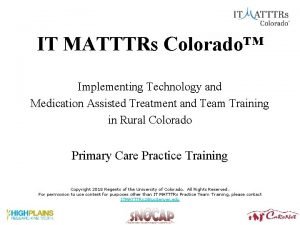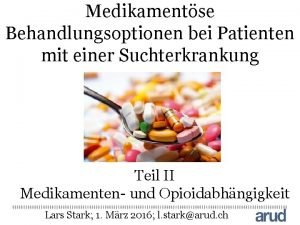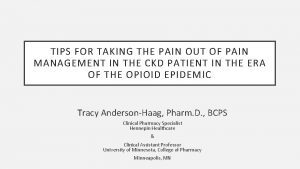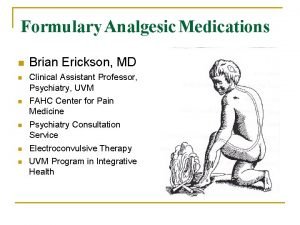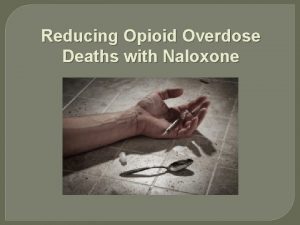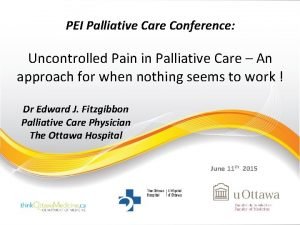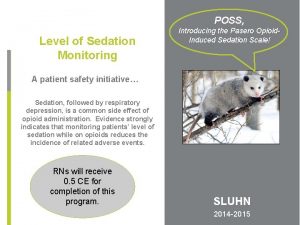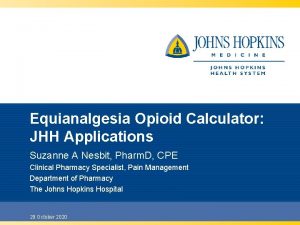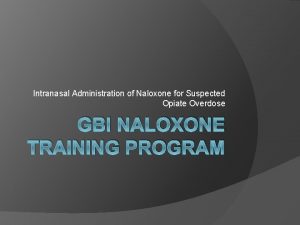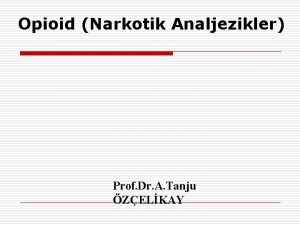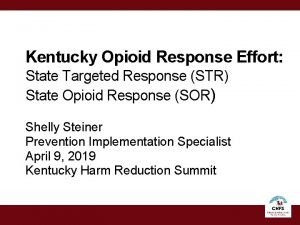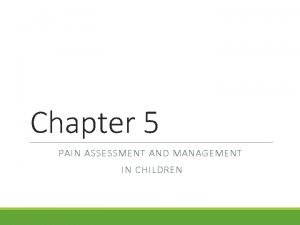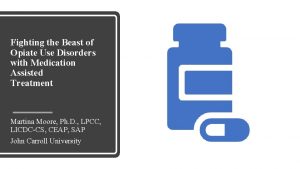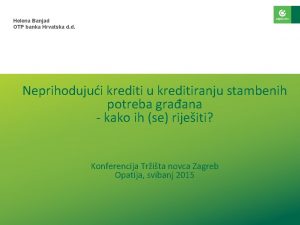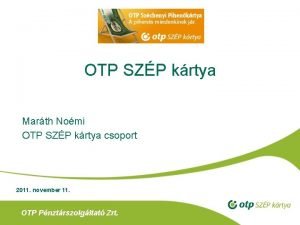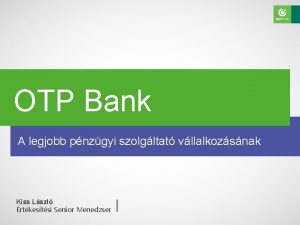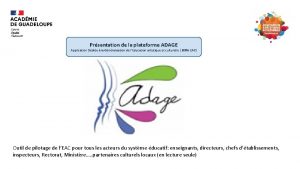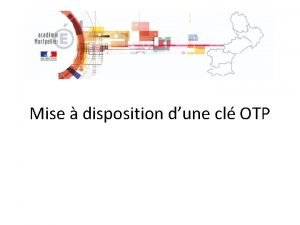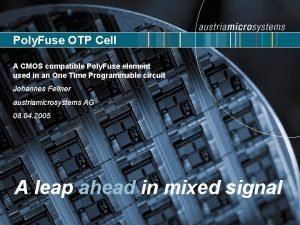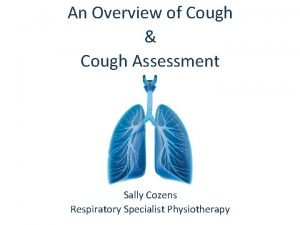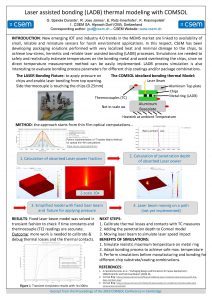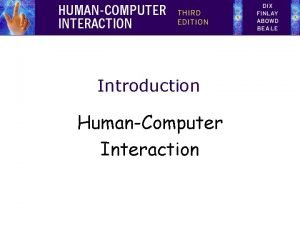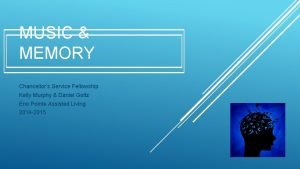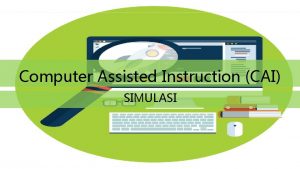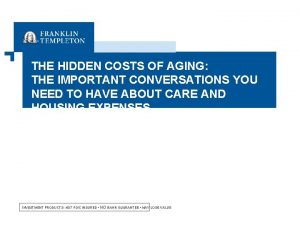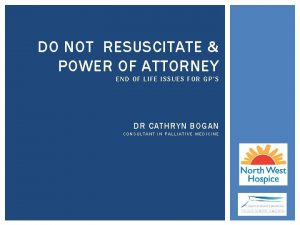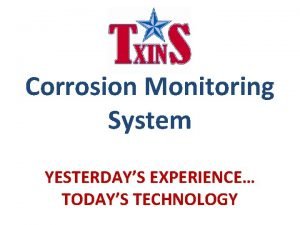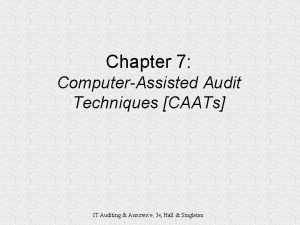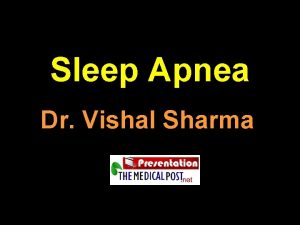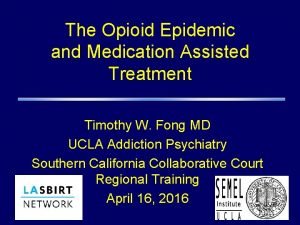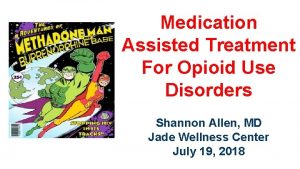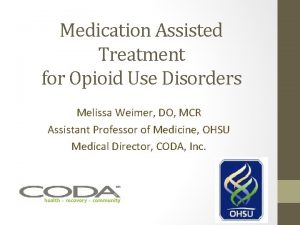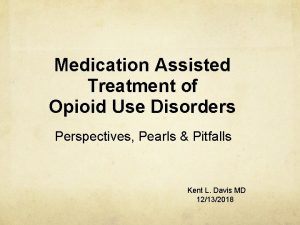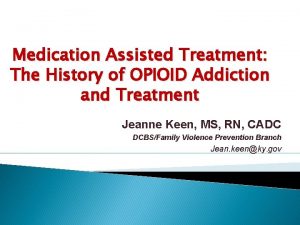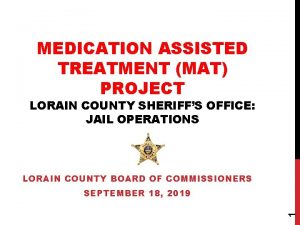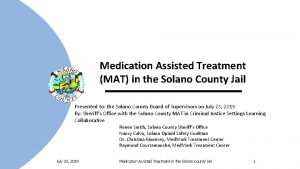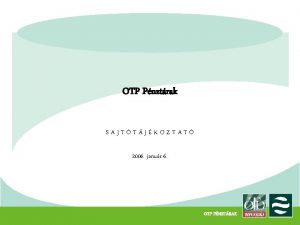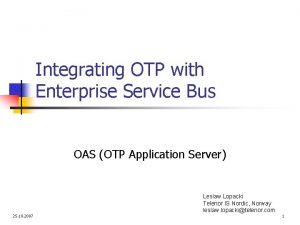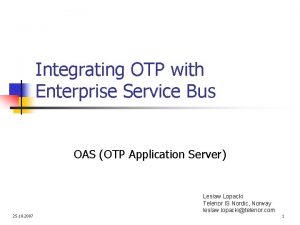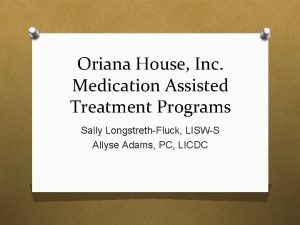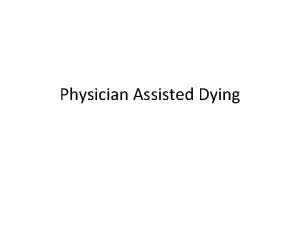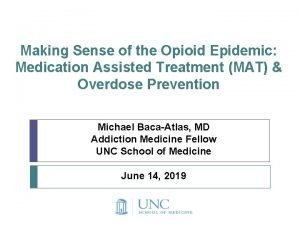Opioid Treatment Programs OTP Medication Assisted Treatment MAT









































- Slides: 41

Opioid Treatment Programs (OTP) & Medication Assisted Treatment (MAT) IN ARMS September 26, 2016 Prepared by Leslie Hulvershorn, MD Medical Director, Division of Mental Health and Addiction, FSSA Leslie. Hulvershorn@fssa. IN. gov Presented by Dennis Ailes, MA Assistant Deputy Director of Addiction Services Division of Mental Health and Addiction, FSSA Dennis. Ailes@fssa. IN. gov

Session Description Medication-assisted treatment (MAT), including opioid treatment programs (OTPs), combines behavioral therapy and medications to treat substance use disorders. Medications, when used in combination with counseling and behavioral therapies, provide a whole-patient approach to the treatment of opioid dependency to help people reduce or quit their use of heroin or other opiates

Summary What are opioids? What are opioid use disorders? What are the treatment options? Why medications? How successful is MAT? What about pregnant women and their babies? What is new in Indiana for the treatment of opioid use disorders?

Opiates Prescription pills: morphine/morphine like substances (e. g. , Oxy. Contin, Percocet, Vicodin, Lortab, Opana, methadone) Pills are ingested, snorted or injected Heroin: Street drug, derived from morphine 23% who try will become addicted Powder is injected, snorted, smoked Produce euphoria and then sedation

Opioid Use Disorders: DSM-5 “Opioid Addiction” Take more than intended Desire/unsuccessful efforts to cut back or quit Time spent using, obtaining or recovering Craving Failure to fulfill work, school, home obligations Continued use despite problems (social, psychological, physical) Activities given up Use in hazardous situations Tolerance Withdrawal

Consequences of Opiate Use Disorder Overdose: respiratory depression Use of narcotic analgesics resulted in nearly ½ million visits to U. S. ED’s in 2007 Injection: HIV and Hepatitis Overdose mortality has been reported with both methadone and buprenorphine

Treatment Options Naltrexone (Vivitrol) Program Buprenorphine Detox/Maintenance Program Methadone Detox/Maintenance Program Opiate Addiction

History of Methadone Synthesized in Germany: Less addictive than morphine 1930 s Used in US for pain 1947 Research demonstrated efficacy for heroin addiction 1964 Federal regulations developed for methadone maintenance treatment 1971 http: //www. cesar. umd. edu/cesar/drugs/methadone. asp Federal regulations updated to allow more effective and consistent use 2001

Federal and State Rules for OTPs

Methadone Maintenance = help avoid negative consequences of illicit opiate misuse Dosed once daily <80 -100 mg daily When properly managed, reduce narcotics related deaths, users' involvement in crime, the spread of AIDS, and helps users gain control of their lives If used correctly, few side effects, no high

Methadone: Does it work? 11 clinical trials More effective than non-methadone treatments at keeping people in treatment, staying off of opiates (Cochrane Review, 2009)

Opioid Treatment Programs (OTPs) Only source of methadone for maintenance (Reminder: Also prescribed by physicians for pain) Provide a multi-modal approach including medication, counseling, and other supportive services, to treat opioid addiction Heavily regulated by state and federal agencies

“Take Homes” Privilege earned through drug screens: Negative for illicit drug use Positive for methadone metabolites Incentive for “good behavior” Improves compliance, sobriety from other drugs

PROS Close supervision: daily dosing CONS Hassle: interfere with employment, parenting, etc. Enforce therapy Expensive Incentivize “take homes” Societal consequences for Most effective treatment take homes

Treatment Options Naltrexone (Vivitrol) Program Buprenorphine Methadone Maintenance Program Opiate Addiction

Buprenorphine/Naloxone Semi-synthetic partial agonist (limited effects) + antagonist Does not require daily dispensing Safer in overdose = much less regulation Easier to stop than methadone, milder withdrawal

Sublingual Film

PROS CONS Convenient $$$$ (now generic) Safer to have at home Still taking an opiate Easier to stop Hard to find qualified providers Less effective than methadone

Treatment Options Naltrexone (Vivitrol) Program Buprenorphine Methadone Maintenance Program Opiate Addiction

Naltrexone Vivitrol (monthly intramuscular injection) FDA approved for alcohol, opiate use disorders Opiate antagonist: blocks receptor

Action of Naltrexone

PROS CONS Non-narcotic $$$$ Cannot decide to “miss a Can cause liver damage dose” Occasional overdoses Must be off opiates for 2 weeks to start

Opiate Use Disorders and Pregnancy Detoxification is associated with high rates of spontaneous abortions in the first trimester and premature delivery in the third trimester Babies exposed to heroin have lower birth weights Babies exposed to heroin were more likely to require morphine than those with methadone treated mothers (40% vs. 19%) Current recommendations: Treat with Methadone or Buprenorphine

Neonatal Abstinence Syndrome “Neonatal abstinence syndrome is an expected and treatable condition that follows prenatal exposure to opioid agonists. ” -American College of Obstetricians and Gynecologists

Benefits vs. Risks: side effects, costs, take home doses Benefits: Decrease drug use, improve health, reduce high risk behaviors, increase employment

What is new in Indiana for Opioid Treatment? Senate Enrolled Act in 2015, SEA 464 SAMSHA Grant: Medication Assisted Treatment – Prescription Drug and Opioid Addiction (MAT-PDOA) Senate Enrolled Act in 2016, SEA 297 26

Opioid Treatment Programs (OTPs) in INDIANA Currently 13 clinics (3 CMHCs) Serve approximately 15, 000 people Can also administer buprenorphine Moratorium on new programs Opioid use disorders are widespread and Indiana is still underserved 27

Senate Enrolled Act 464 28

Senate Enrolled Act 464 Effective July 1, 2015 the following types of entities may apply to the Division to operate an Opioid Treatment Program Ø Licensed Hospital under IC 16 -21 Ø Licensed Private Psychiatric Institution (PIP) under IC 12 -25 Ø Community Mental Health Center under IC 12 -21 29

Senate Enrolled Act 464 Ø Before June 30, 2018, the division may approve the operation of not more than five (5) additional opioid treatment programs only if the division determines that there is a need for a new opioid treatment program in the proposed location and the requirements of this chapter are met. All approvals need to be in compliance with the article and federal law. 30

Senate Enrolled Act 464 (continued) The report must include the following: (1) The impact on access to opioid treatment programs. (2) The number of individuals served in the opioid treatment programs approved under subsection (c). (3) Treatment outcomes for individuals receiving services in the opioid treatment programs approved under subsection (c). (4) Any recommendations the division has concerning future treatment programs. 31

Senate Enrolled Act 464 (continued) Location, Location Ø (e)The division shall adopt rules under IC 4 -22 -2 setting forth the manner in which the division will determine whethere is a need for a new opioid treatment program in a proposed program location’s geographic area. 32

The State of Illinois currently has 71 Certified Opioid Treatment Programs. Indiana Map of Opioid Treatment Programs The State of Kentucky currently has 15 Certified Opioid Treatment Programs. The State of Ohio currently has 24 Certified Opioid Treatment Programs. The State of Michigan currently has 41 Certified Opioid Treatment Programs. 33

Process to Become a Certified Opioid Treatment Clinic Ø Application for certification and accreditation from SAMSHA/CSAT and within CSAT to the Division of Pharmacologic Therapies (DPT). http: //www. dpt. samhsa. gov/regulations/regindex. aspx Ø Must obtain a separate Drug Enforcement Administration (DEA) registration as a Narcotic Treatment Program, to administer and dispense approved Schedule II controlled substances (that is, methadone) for maintenance and detoxification treatment. http: //www. deadiversion. usdoj. gov Ø Application to the Division of Mental Health and Addition (DMHA) to become a Certified Opioid Treatment Program. 34

Process to Become a Certified Opioid Treatment Clinic (continued) SAMHSA-Approved Opioid Treatment Program Accrediting Bodies Ø Commission on Accreditation of Rehabilitation Facilities (CARF) 6951 East Southpoint Road Tucson, Arizona 85756 http: //www. carf. org Ø Council on Accreditation (COA) 45 Broadway, 29 th Floor New York, New York 10006 Telephone: 212 -797 -3000 ext. 268 or 866 -262 -8088 Fax: 212 -797 -1428 http: //www. coanet. org Ø Division of Behavioral Health, Missouri Department of Mental Health 1706 East Elm St. P. O. Box 687 Jefferson City, Missouri 65102 Telephone: 573 -526 -4507 Fax: 573 -751 -7814 http: //dmh. mo. gov/ada/index. htm 35

Next Steps for Division of Mental Health & Addiction • Rule outlining determination of need has been written and process of promulgation completed September 2016 • A request for information (RFI) will likely be published and applications will be solicited. • An agreement with up to 5 programs will be made…then those programs can begin the process to apply for all the relevant approvals and certifications (DEA, SAMHSA, CARF, DMHA, State Pharmacy Board, etc. ) 36

Medication Assisted Treatment – Prescription Drug and Opioid Addiction (MAT-PDOA) SAMHSA Grant 37

Medication Assisted Treatment – Prescription Drug and Opioid Addiction (MAT-PDOA) WHAT? : Federal funding to promote the use of medication assisted treatment for opioid use disorders WHO? : Individuals with lower income in rural areas, and those at-risk for HIV, Hepatitis C WHERE? : Lake, Porter, Starke and Scott Counties HOW MANY? Up to 500 people WHEN? : Started in January 2016 FOR HOW LONG? : 3 years 38

What does the grant fund Medication Assisted Treatment Outreach efforts Recovery supports (transportation, child care, financial support) Case management (link to mental health, medical, vocational and educational services) Testing and education for HIV and Hepatitis C 39

Senate Enrolled Act 297 SEA 297 – Expands the criteria FSSA Medicaid uses to determine medical necessity for inpatient detoxification and requires Medicaid coverage for inpatient detoxification in accordance with ASAM (American Society of Addiction Medicine) Patient Placement Criteria to include treatment of opioid or alcohol dependence. SEA 297 is a product of the Attorney General’s Prescription Drug Abuse Prevention Task Force.

Questions?
 Medication assisted treatment colorado
Medication assisted treatment colorado Disadvantages of waterfall model in software engineering
Disadvantages of waterfall model in software engineering Opioid receptors location
Opioid receptors location äquivalenzdosis opioide
äquivalenzdosis opioide Types of pain
Types of pain Non-opioid
Non-opioid Opioid overdose
Opioid overdose Mechanism of action of opioid analgesics
Mechanism of action of opioid analgesics Poss sedation scale
Poss sedation scale Opioid settlement calculator
Opioid settlement calculator Opioid overdose
Opioid overdose Elisha peterson md
Elisha peterson md Opioid analjezikler
Opioid analjezikler Kentucky opioid response effort
Kentucky opioid response effort Non-opioid
Non-opioid Opioid overdose
Opioid overdose Otp banka lastovska
Otp banka lastovska Trust pad token
Trust pad token Otp implementation picoctf
Otp implementation picoctf Otp direkt szép kártya
Otp direkt szép kártya Legjobb bank magyarországon
Legjobb bank magyarországon Arena otp guadeloupe
Arena otp guadeloupe Schrankó péter
Schrankó péter Clef otp
Clef otp Cmos
Cmos Otp turistički krediti
Otp turistički krediti Otp egészségpénztár beiskolázási támogatás
Otp egészségpénztár beiskolázási támogatás Otp ep egyenleg
Otp ep egyenleg Eigrp otp
Eigrp otp Manual assisted cough
Manual assisted cough Laser assisted bonding
Laser assisted bonding Why assisted suicide is bad
Why assisted suicide is bad Online proctored exams candidate guidelines peoplecert
Online proctored exams candidate guidelines peoplecert Information reproduced from memory can be assisted by cues
Information reproduced from memory can be assisted by cues Eno pointe assisted living
Eno pointe assisted living Contoh cai
Contoh cai Hidden costs of assisted living
Hidden costs of assisted living Power of attorney do not resuscitate form
Power of attorney do not resuscitate form Hydrogen assisted cracking
Hydrogen assisted cracking Test data method auditing
Test data method auditing Linguloplasty
Linguloplasty Assisted service restaurant
Assisted service restaurant
